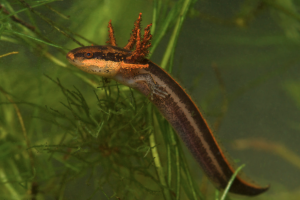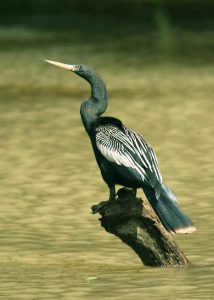Podcast: Play in new window | Download (Duration: 10:11 — 11.9MB)
Thanks to Kai and Emily for their suggestions this week!
The greater siren [photo by Kevin Stohlgren, taken from this site]:

The anhinga [photo by Tim from Ithaca – Anhinga, CC BY 2.0, https://commons.wikimedia.org/w/index.php?curid=15526948]:

An anhinga swimming [photo by Wknight94, CC BY-SA 3.0 <https://creativecommons.org/licenses/by-sa/3.0>, via Wikimedia Commons]:

Show transcript:
Welcome to Strange Animals Podcast. I’m your host, Kate Shaw.
This week we’re going to learn about two animals, one suggested by Kai and the other suggested by Kai’s mom Emily. It’s so awesome to hear when families like to listen to the podcast together. This episode even includes a mystery animal I bet you’ve never heard of.
Let’s start with Kai’s suggestion, the greater siren. The greater siren is an amphibian, specifically a salamander, but it’s probably not the kind of salamander you’re thinking of. For one thing, it can grow over three feet long, or about a meter, which is pretty darn big for a salamander. It’s dark green or gray in color with tiny yellow or green speckles, and while it has short front legs, those are the only legs it has or needs. It also has external gills which it keeps throughout its life, unlike most salamanders who lose their external gills when they metamorphose into adults.
The greater siren lives primarily in Florida, but it’s also found in coastal wetlands throughout much of the southeastern United States. It’s mostly nocturnal and during the day it hides among water plants or under rocks, and will even burrow into the mud. At night it comes out to find food, which includes crayfish and other crustaceans, insects and spiders, little fish, other amphibians, snails, and even algae. It swallows its food whole, even snails and other mollusks. It poops out the shells and other undigestible pieces.
The grater siren’s body is long but thin, sort of like an eel, with a rounded tail that’s slightly flattened to help it swim. While it does spend its whole life in the water, it has small lungs that allow it to breathe air if it needs to. It can wriggle above ground for short distances if it needs to find a new pond or river, and sometimes it will sun itself on shore. In drought conditions when its water dries up, the greater siren will burrow into the mud and secrete mucus that mixes with dead skin cells to form a sort of cocoon. The cocoon covers everything but the siren’s mouth, so it can still breathe. Then it enters a state of torpor called aestivation, and it can stay in its mud cocoon for a long time, possibly as much as five years, and still be fine once the water returns. It does lose a lot of its body fat and its gills wither away, but it regenerates them quickly once it has water, and will gain weight quickly too once it has food.
In early spring, the female siren lays her eggs in shallow water. The male fertilizes them and takes care of them for the next two months, when they hatch into little bitty sirens that go off on their own right away.
The greater siren has tiny eyes and probably doesn’t see very well. It has a good sense of smell instead, and it can also sense movement and vibrations around it with its lateral line system. This is an organ found in many fish and a lot of larval amphibians, although the greater siren retains it throughout its life. It allows the animal to sense the movement of water in extremely fine detail. The greater siren can probably also sense electrical impulses, which is something that all animals generate when they use their muscles.
If there’s a greater siren, you may be thinking, there must be a lesser siren too. There is, and it’s very similar to the greater siren, just not as big. It only grows about two feet long at most, or 61 cm.
Kai mentioned that the greater siren looks a lot like the axolotl, a critically endangered salamander found only in Mexico. I checked to see if the two salamanders were closely related and was actually surprised to find that they’re not. They’re both salamanders and therefore share the same order, but that’s all. The greater siren and its close relations do share one important trait with the axolotl, though, which is neotony. Neotony is when an adult organism retains juvenile traits, which in the case of the salamander means it retains gills and lives underwater as an adult.
Next, Emily wanted to learn more about a bird called the anhinga. It’s sometimes called the snakebird because it has a long, serpentine neck. But before we learn about the anhinga, let’s learn about a mystery animal from Kentucky. I promise this will make sense in a minute.
In 1993 a man named Barton Nunnelly and his wife were sitting in their back yard in Stanley County, Kentucky. It was a nice day and their house was close to the Ohio River, so as they often did they just relaxed and watched the river. On this particular day, they both noticed a strange animal in the water. It was snake-like with a bill similar to a duck’s, but it obviously wasn’t a duck. It swam with its head and neck above the water, but its body was never visible. It frequently sank into the water, then surfaced elsewhere. The couple watched the animal for half an hour before it disappeared downstream.
For most people, that sighting would just be an interesting story to tell at parties, but Barton Nunnelly was a cryptozoologist. That’s someone who likes to investigate mystery animals, and while it’s a great word, it’s not an official branch of science. Zoologists, biologists, and other scientists study mystery animals all the time as part of their jobs. Nunnelly investigated—and in fact still does investigate, since he’s alive and well—mystery animals that are a lot more mystery than animal, like Bigfoot. He wrote about his sighting of what he thought might be a young freshwater sea serpent in his book Mysterious Kentucky.
Now, with Nunnelly’s sighting in mind, let’s return to the anhinga and learn a little more about this unusual bird. It can grow almost three feet in length, or about 90 cm, with a nearly four-foot wingspan, or 115 cm. A lot of its body length is due to the long neck. The male is black all over with a white tail-tip, while the female looks similar but has a brown head and neck. It looks similar to the double-crested cormorant, a close relation, but it has a longer, sharper bill. It lives throughout much of South and Central America, and is also common around the Gulf of Mexico and parts of the southeastern United States. In North America it usually stays near the coast or around wetlands, but sometimes it’s found farther inland, especially along rivers.
The most interesting feature of the anhinga is the way it hunts. It has big webbed feet and swims extremely well, and it hunts fish, frogs, and other small animals underwater. Unlike other water birds, which have water-repellent oils coating their feathers, as soon as the anhinga gets in the water, its feathers get all wet. This causes it to lose buoyancy and sink, but that’s just fine with the anhinga. It also has dense bones compared to most birds, which helps it stay underwater. The bird swims underwater until it gets close to a fish or other prey animal. Then it stabs the animal with its sharp bill, before bringing it above water to swallow. Often it will swim with its body completely submerged but its head and neck sticking up out of the water.
One interesting fact about the anhinga is that it has no nostrils. It can only breathe through its mouth. It can hold its breath underwater for about four minutes and during that time can travel quite a distance, up to about 100 yards, or 90 meters, completely underwater. In addition to fish and frogs, it will eat crayfish, crabs, insects, water snakes, and lots of other small animals. After it’s done hunting, or if it wants a rest, it will stand in the sun with its wings spread in order to dry its feathers. Cormorants do this too for the same reason.
Now, think back to Barton Nunnelly’s sighting of a duck-billed water serpent. It sounds to me an awful lot like Nunnelly saw an anhinga hunting in the river. It’s a rare visitor that far inland, but not unheard of. Naturally, not everyone knows every single bird in the world, but I feel like if you’re going to write a book about mystery animals, you should do a little research first. But maybe that’s just me.
You can find Strange Animals Podcast at strangeanimalspodcast.blubrry.net. That’s blueberry without any E’s. If you have questions, comments, or suggestions for future episodes, email us at strangeanimalspodcast@gmail.com. We also have a Patreon at patreon.com/strangeanimalspodcast if you’d like to support us for as little as one dollar a month and get monthly bonus episodes.
Thanks for listening!